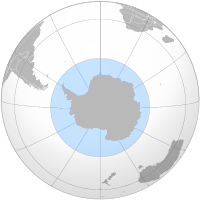
Photo from wikipedia
Satellites Over Seals (SOS), a project initiated in late 2016, is a crowdsourced method to determine factors behind the presence/absence patterns and to ultimately determine the global population of the… Click to show full abstract
Satellites Over Seals (SOS), a project initiated in late 2016, is a crowdsourced method to determine factors behind the presence/absence patterns and to ultimately determine the global population of the Weddell seal (Leptonychotes weddellii). An iconic species, the Weddell seal is proposed to be part of the Antarctic Research and Monitoring Program required in the newly designated Ross Sea Region Marine Protected Area. This species is easy to detect via satellite imagery, due to its large size (3–4 m long, 1 m wide) and its dark color contrasting with the Antarctic coastal fast ice, where it aggregates on during breeding season. Using very high‐resolution satellite imagery (VHR; 0.31–0.60 m resolution) and the online platform Tomnod, we used VHR images from November 2010 and 2011 to cover the entirety of available fast ice around Antarctica. Before correcting for time of day or date, we searched for the presence/absence to identify a subset of where abundance estimates should be concentrated. More than 325 000 citizen scientists searched 790 VHR images, covering 268 611 km2 of fast ice, to determine the locations of seals. Algorithms ranked searchers to the degree their votes corresponded with others, a measure of searcher relative quality that we used to filter out unreliable searchers. Seal presence was detected on only 0.55% of available maps (total n = 1 116 058) within fast ice, revealing a sparse, irregular distribution. The rate of false‐negative detections was 1.7%, though false positives were high (67%), highlighting the importance of training for image interpretation to ensure differentiation between seals and landscape features (such as large rocks, ice chunks or depressions/holes in the ice). This approach not only allowed us to assess image resolution and quality, but also training, outreach and the effectiveness of this platform for introducing citizen scientists to the ecology of the Southern Ocean.
Journal Title: Remote Sensing in Ecology and Conservation
Year Published: 2019
Link to full text (if available)
Share on Social Media: Sign Up to like & get
recommendations!